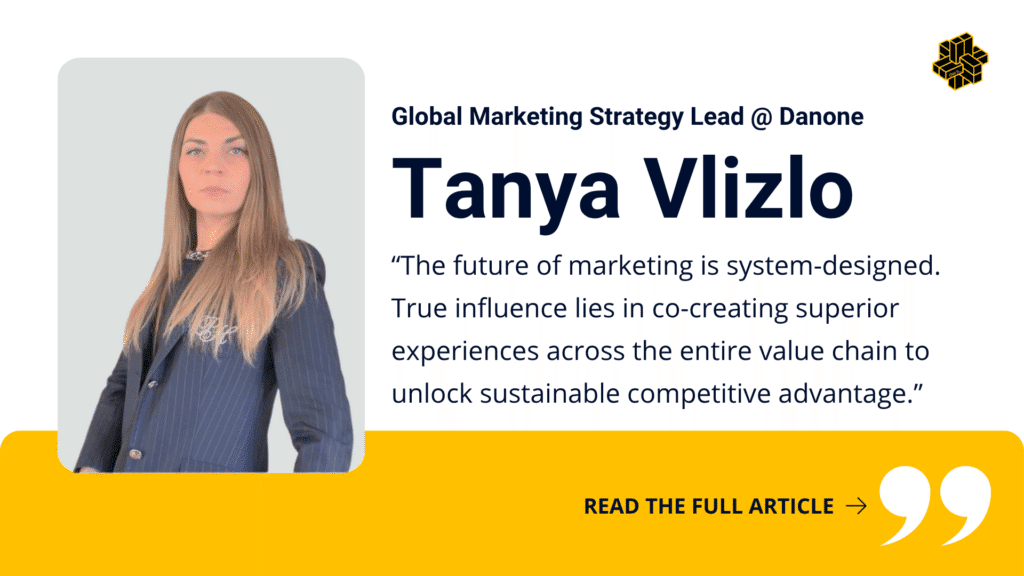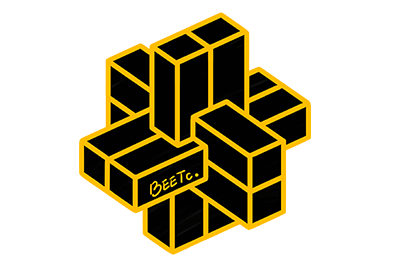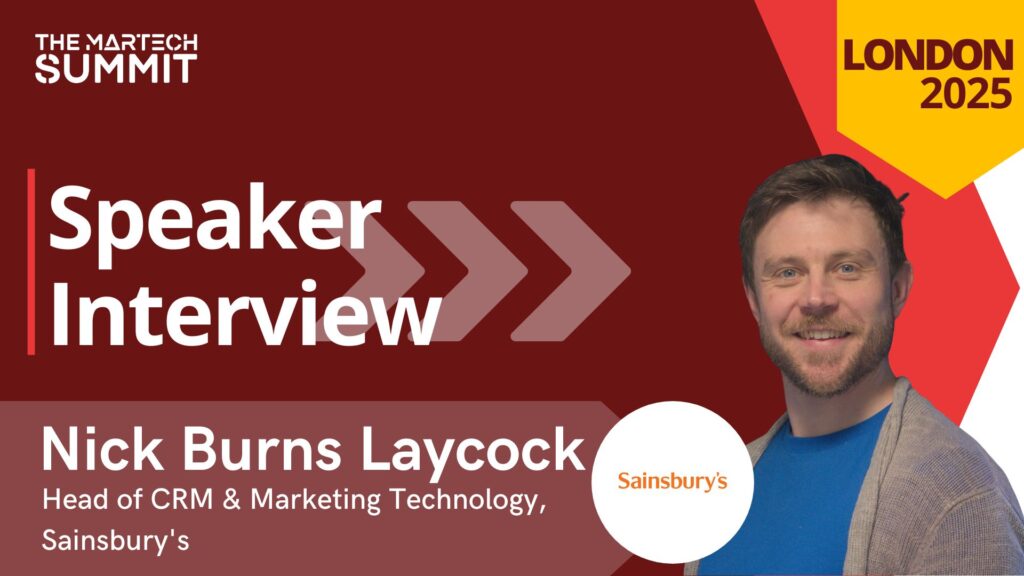
Marketing is no longer a linear game of persuasion – it is a living, evolving ecosystem of experiences. In this in-depth piece, Tanya Vlizlo invites us to reimagine what it truly means to lead in the age of Marketing 6.0. Drawing on decades of industry evolution and emerging technologies, she positions the modern marketer not just as a communicator, but as a Systems Architect – someone who designs immersive, emotionally resonant innovations that blend strategy, creativity, and purpose. If you’ve ever questioned what comes after customer centricity, this article will open a whole new lens through which to view influence, value creation, and growth.
About Tanya Vlizlo
Tanya Vlizlo is a cross-industry marketing and business strategy leader with over 13 years of experience driving transformation at global Fortune 500 companies such as PepsiCo, Johnson & Johnson, and Danone. Renowned for building brands at the intersection of beauty, wellness, nutrition, and health, Tanya brings a distinctive systems-thinking approach to modern marketing. Her work spans from strategic P&L turnarounds to pioneering digital-first ecosystems, and she is especially passionate about empowering individuals and businesses to thrive through emotionally resonant and purpose-driven innovation. As a consultant and personal brand coach, she has mentored professionals and startups alike, crafting narratives that spark both impact and growth.
Introduction
Marketing’s evolution is accelerating like never before driven by rapid technological advances, rising consumer expectations, and an overwhelming array of choices that fragment attention.
“Technology is transforming choice, and choice is transforming the marketplace.”
—Regis McKenna
Driving growth and influence today – especially in oversaturated industries like Beauty and FMCG, in complex categories like Healthcare, or when introducing disruptive value propositions – requires a shift from linear strategies to system thinking.
Historically, marketing strategies have evolved from product-centric campaigns to customer-centric journeys. Now, the frontier is ecosystem-centric growth – an approach rooted in co-creation, systems thinking, and orchestration.
“Leadership today is about ecosystem thinking—constantly innovating and aligning partners to co-create value at scale.”
—Satya Nadella
In marketing, an ecosystem approach means aligning diverse stakeholders—customers, partners, competitors, and internal teams—around a shared understanding of the customer, market dynamics, and cultural trends. It focuses on designing superior experiences—not just better products—and co-creating value across the entire value chain to unlock sustainable competitive advantage.
Drawing from John Sterman’s systems-thinking work, a marketing ecosystem is not a collection of isolated activities, but a dynamic network of interdependent actors, structures, and feedback loops that co-create market outcomes. In this model, marketing transcends silos to orchestrate influence and integration across the system1
This ecosystem perspective naturally expands into broader systems thinking—embracing complexity, adaptation, and continuous learning across interconnected processes and actors.
CHAPTER 1: The Evolution of Marketing — and the role of the Marketeer
Marketing has never stood still.
Its evolution is perhaps most famously captured by the “Marketing X.0” framework2, which reflects how marketing’s role, tools, and philosophy have continually shifted to keep pace with advances in technology, changes in human behavior, and shifts in societal values.
But to understand the evolution of the marketer—not just marketing—you have to look beyond frameworks. It requires exploring the intersections where marketing blends with other disciplines: strategy, psychology, behavioral science, economics, design, and systems thinking.
Today’s most effective marketers are grounded in strategic thinking and first principles. This foundation allows them to do more than react to change—it empowers them to anticipate shifts, interpret weak signals, and actively shape what comes next.
As Roger Martin puts it:
“Marketing’s role today is not just to identify customer needs but to integrate these with business strategy, balancing insights about consumers’ emotional desires with customers’ commercial imperatives”
When I began my marketing career back in 2012, human centricity was already a well-established theme—accurately captured in Kotler’s Marketing 3.0 framework2. This era of marketing emphasized that consumers are not just buyers of products, but whole humans—driven by values, aspirations, and identity. It marked the shift from product-driven messaging to purpose-driven branding.
But this evolution was not just about changing the message. It demanded a fundamental shift in how marketers operated and thought about their role.
Strategic management’s dynamic capabilities taught firms to quickly adapt resources to changing customer needs. Network strategies helped companies leverage broader ecosystems of partners and expertise to innovate and respond to disruption.
The rise of behavioral economics challenged the classical view of consumers as purely rational agents, revealing that decisions are deeply emotional, unconscious, and influenced by cognitive biases and social cues. This insight helped marketers move beyond persuasion to build emotional resonance—a key competitive differentiator3.
People decide based not only on price or features but on how a brand makes them feel and fits into their worldview.
According to Harvard Business Review, emotional bonds drive 2 to 3 times greater customer lifetime value than rational benefits alone. This insight elevated emotional connection as a key competitive differentiator4.
As a result, the marketer’s role expanded: they became Values-Driven Marketing Architects—leaders responsible for building cross-functional capabilities, embedding purpose at the core of business strategy, and translating customer insight into tangible business impact.
Brands as Culture Shapers and Experience Creators
Brands evolved from simply communicating product benefits to shaping culture and creating meaningful experiences. Purpose became central — brands were expected to stand for something and engage with empathy and clarity. This era also saw the rise of immersive, multisensory experiences that connected consumers emotionally, moving beyond functionality to deeper engagement.
Iconic Examples of Purpose-Led, Experiential Marketing
Patagonia — “Don’t Buy This Jacket” (2011)5
Challenged consumerism and called for environmental responsibility, positioning Patagonia as a pioneer of sustainable, values-led marketing. It invited customers to join a movement, not just make a purchase.

Dove — Real Beauty Sketches (2013)6
Sparked a global conversation on self-esteem and beauty standards through authentic storytelling. It redefined corporate social responsibility by showing how emotional connection drives cultural change and loyalty. To date, viewed 180 million times.

https://youtu.be/rrHoDJinMQI?si=IVo4KLW1tjTZ3JDt; see its evolution in AI era: https://youtu.be/8vYoL8nga-A?si=T9FoFdoc3xb7hrf7
The Persistent Challenge: Marketing’s Struggle for Recognition
Despite its evolution, marketing is still often seen as a cost center with impact measured by brand metrics rather than direct financial returns, making ROI difficult to prove and its role in long-term value creation frequently underappreciated.
Marketing 4.0: The Digital Revolution and the Rise of the Digital Architect
Following the purpose-driven and experiential marketing era, the period from roughly 2014 to 2017 marked a dramatic evolution in marketing driven by the digital revolution. This era, often described as Marketing 4.0, blended digital agility, personalization and omnichannel engagement2.
Two strategic frameworks were especially influential during this period: Blue Ocean Strategy7 encouraged brands to innovate by creating new market spaces rather than competing in crowded fields, while Behavioral Economics — including Nudge Theory and Choice Architecture8—helped redesign consumer experiences to subtly guide decisions. These approaches fueled breakthrough innovation, expanding marketing beyond communication to active experience creation.
Innovation in customer experience became central, with marketers using data to personalize offerings, simplify choices, and build seamless omnichannel journeys. Platform thinking extended innovation beyond company walls through partnerships and startup collaborations9, transforming marketers into Digital Architects who integrate technology, data, and creativity for product and service innovation.
Iconic Examples of Marketing 4.0 Innovation
Stitch Fix’s Personalized Styling (Mid-2010s)10
Reinvented fashion retail by sending personalized boxes styled with AI and human insight. This blend of technology and creativity created a new market space with curated fashion delivered to customers’ doors. Led by Katrina Lake, Stitch Fix became a massive success, one of the most innovative players of the 4.0 era and an early prototype of Marketing 5.0 thinking. More on Stitch Fix
The Digital Revolution and Marketing’s Growing Business Impact
New digital tools enabled precise tracking of clicks (CTR), CPA, leads, and conversions, linking marketing efforts more directly to revenue. This increased accountability elevated marketing’s strategic role within organizations. However, long-term ROI remained complex due to attribution challenges across fragmented customer journeys spanning online, in-store, and third-party touchpoints, setting the stage for Marketing 5.0.
Marketing 5.0: The Customer Advocacy Journey and the Rise of the Ecosystem Architect
Following Marketing 4.0, the period from 2017 companies compete as ecosystems, connecting consumers, partners, creators, and data through platforms. These ecosystems leverage platform economics and network effects to scale rapidly and deepen personalization.
The Rise of Marketing 5.0
Within this environment, Marketing 5.02 emerged as a comprehensive framework for designing and managing end-to-end customer journeys across complex, connected ecosystems. Key capabilities included: AI, machine learning, Agile marketing operations and a commercial mandate, with marketing driving measurable contributions to revenue, margin, and shareholder value.
This evolution marked a fundamental transformation in how brands create, deliver, and sustain value in a digital-first, platform-driven world. The goal is no longer just conversion—it’s advocacy. In an ecosystem world, a top customer is a value amplifier: they share, influence, co-create, and bring others into the platform through their own credibility and experiences.
The marketer’s role evolved into the Ecosystem Architect—designing seamless, multi-stakeholder customer journeys that drive advocacy and value creation.
Iconic Examples of Ecosystem-Led Marketing
Brands in saturated markets like beauty and FMCG built digital ecosystems blending mobile apps, e-commerce, personalization, and community. Key innovations include AR-powered virtual try-ons and subscription models that extend customer lifetime value. Sephora leads with AI-driven product recommendations, subscription services, and rich community content, delivering hyper-relevant offers in real time11. https://youtu.be/NFApcSocFDM


Screenshots from 2018 of Sephora Virtual Artist App, source
In regulated, trust-intensive industries like healthcare, digital ecosystems support essential service delivery by connecting patients, caregivers, professionals, and insurers, enabling personalized care through remote monitoring, AI-driven coaching, and data integration that enhances outcomes.
MARKETING as Business Growth Engine
As platform thinking expanded, marketing became central to growth — designing interconnected journeys and cultivating advocacy. Dynamic feedback loops capture real-time user behavior and engagement, enabling continuous optimization. Key KPIs now include Customer Lifetime Value (CLV), Net Promoter Score (NPS), marketing-influenced revenue, and profit margin improvements, highlighting marketing’s measurable impact on business performance.
CHAPTER 2: The New Era of Marketing
Marketing 6.0: Metamarketing and the Rise of the Systems & Purpose Architect
Marketing 6.0 responds to Gen Z and Gen Alpha’s evolving expectations—digital natives shaped by AI, spatial computing, Web3, and ambient interfaces. These technologies aren’t just tools but the very mediums through which immersive, authentic, inclusive, and purposeful brand experiences unfold2
These audiences crave immersive, hybrid experiences that blend physical and digital worlds. Through multisensory engagement, spatial marketing, and metaverse technologies, companies are crafting transformative customer journeys—reshaping the future of brand experience.

This evolution shifts marketing’s focus from just product to holistic experience design. At its core lies Systems & Complexity Thinking1—a mindset that embraces feedback loops, emergent behavior, and adaptation. It equips marketers to navigate dynamic ecosystems and co-create value in an ever-evolving landscape.
As a result, marketers evolve into Systems & Purpose Architects, tasked with simplifying complexity while aligning brand purpose with the well-being of customers, communities, and the planet.
With these new responsibilities come tough but essential questions that marketers must ask themselves2:
- Who is winning and who is losing — and why?
- Are you doing anything truly exciting and innovative today?
- If not, it’s time to rethink—with ethics, transparency, and sustainability at the core.
Marketing 6.0 is more than good intentions; it delivers measurable business impact. New tech-driven strategies now link directly to real outcomes like revenue growth, cost savings, and stronger customer retention, proving that purpose and performance can coexist.
MetaMarketing: The Next Stage of Omni2
Building on these principles, MetaMarketing represents the next stage beyond traditional omnichannel approaches. By blending physical and digital, brands deliver fully immersive experiences. This era is powered by tech enablers such as AI, spatial computing, blockchain, AR, VR, and more—unfolding across two key environments:
- Extended realities — digitally augmented physical spaces
- Metaverses — virtual worlds offering experiences closely resembling real life

Within these environments, the focus is on creating multisensory, spatial, and metaverse-driven innovation and marketing experiences that redefine customer engagement and immersion – a concept I call “InnoXperience”. This blend of innovation and experience captures the essence of Marketing 6.0’s potential to transform how brands connect with their audiences on deeper, more immersive levels.
“InnoXperience – the art & science of creating unique, emotionally resonant innovations where experience is embedded from the start—making every solution desirable, immersive, and purpose-driven”
– Tanya Vlizlo
Real-World Pioneers in Marketing 6.0
Prada Beauty’s digital launch exemplifies MetaMarketing, creating a 3D virtual store where customers could explore products and engage with immersive content. It marked a shift transforming product interaction into a holistic, purpose-driven event that resonates emotionally and ethically with today’s conscious consumers12.


But to scale such efforts and earn a seat at the executive table, marketers must also prove commercial impact. This requires rethinking how success is measured.
Modern marketers move beyond impressions and clicks, tracking engagement quality, brand equity, and co-creation to measure deeper emotional and experiential value.
CHAPTER 3: Flywheel of the Modern Holistic Marketing Leader
To succeed as a modern marketing leader, one must balance three interdependent dimensions: strategic vision to navigate complex ecosystems, economic awareness to understand evolving markets, and advanced marketing capabilities to deliver meaningful, immersive experiences.

Together, these pillars form the foundation for holistic leadership that drives sustained growth and innovation.
5 Key Shifts for Marketing
To stay future-fit in a rapidly evolving landscape, marketing leaders benefit from embracing five key shifts in capabilities that help them navigate complexity, harness technology, and create purposeful, immersive experiences.
- Customer and Multistakeholder Centricity
Influence complex networks of customers, communities, creators, and platforms, ensuring all voices and needs remain central. - Data and Technology as Enablers
Leverage data and tech to track impact, unlock revenue, and power continuous feedback loops for hyper-personalization and improvement. - Agility with a Systems Mindset
Manage dynamic ecosystems of stakeholders, technologies, and processes—adapting quickly through continuous learning and feedback. - Meta-marketing: Beyond Digital, Into Immersion
Design immersive, participatory experiences by blending multisensory marketing, spatial/contextual AR, and metaverse engagement. - Purpose-Led, Supply driven Innovation: Future innovation will come from seamlessly embedding service and experience into the supply chain itself. Amazon and Netflix value creation is powered by tightly integrated systems that align logistics, data, and customer experience at every step.

The Modern Marketer – The Systems Architect
In today’s complex, interconnected landscape, marketing goes beyond managing ecosystems to embracing full systems thinking—a mindset that navigates dynamic networks, feedback loops, and emergent behaviors. The modern marketer is a Systems & Purpose Architect—driving “InnoXperience,” where innovation is seamlessly embedded within immersive, interconnected experiences. The call to action is clear: adopt systems thinking to innovate, adapt, and lead with purpose in an ever-evolving marketing landscape.
In a world where marketing is rapidly shifting from campaigns to conversations, and from products to purpose, Tanya Vlizlo’s call to action is clear: the future belongs to those who lead with systems thinking, emotional intelligence, and a deep commitment to meaningful innovation. The era of the Systems Architect is here – and it asks marketers not just to adapt, but to design the ecosystems that define how brands live, breathe, and inspire. Whether you’re a seasoned leader or an aspiring changemaker, the insights within this article serve as a compass for navigating the next frontier of marketing leadership.
Sources:
- John D. Sterman (2000), Business Dynamics: Systems Thinking and Modeling for a Complex World, Irwin/McGraw-Hill.
- Philip Kotler, Hermawan Kartajaya & Iwan Setiawan(2023), Marketing 6.0: The Future Is Immersive
- Behavioral Economics – The Full Guide & Examples (2024)
- “An Emotional Connection Matters More than Customer Satisfaction” by Scott Magids, Alan Zorfas, and Daniel Leemon (August 2016).
- https://www.patagonia.com/ nyt_11-25-11.pdf
- Real Beauty Sketches | Dove
- W. Chan Kim and Renée Mauborgne (2005), Blue Ocean Strategy: How to Create Uncontested Market Space and Make the Competition Irrelevant, Harvard Business Review Press.
- Richard H. Thaler and Cass R. Sunstein (2008), Nudge: Improving Decisions About Health, Wealth, and Happiness, Yale University Press.
- Geoffrey G. Parker, Marshall W. Van Alstyne, and Sangeet Paul Choudary (2016), Platform Revolution: How Networked Markets Are Transforming the Economy—and How to Make Them Work for You, W. W. Norton & Company. Henry W. Chesbrough (2003), Open Innovation: The New Imperative for Creating and Profiting from Technology, Harvard Business School Press.
- Katrina Lake (2020), The Story of Stitch Fix: Personalization at Scale, Harvard Business School Case 9-718-453, Harvard Business Publishing.
- Retail: A closer look at current trends impacting specialist retailers, Deloitte
- (4) Post | Feed | LinkedIn
Join Us Now!
Ready to elevate your marketing strategy? Be part of our 2025 summits – where innovation, networking, and cutting-edge insights meet in vibrant cities around the world. We can’t wait to welcome you in person!
➡ Explore the 2025 full calendar here! https://beetc.io/2025-full-event-calendar-beetc/
Can’t attend in person? No problem. Join BEETc On-Screen, our On-Demand Learning Platform, for exclusive access to 500+ sessions and over 300 hours of content from global summits. Upskill at your own pace, gain actionable insights, and stay ahead in a rapidly evolving business landscape.
➡ Explore content from global summits! https://beetc.io/on-screen/
Stay up to date with our In Person Summit, Session Information, and Agenda Updates by following us on:
See more MarTech Thoughts Content/ Interview pieces here!
Last updated: July 2025













